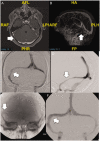Management of idiopathic intracranial hypertension in children utilizing venous sinus stenting
- PMID: 33236688
- PMCID: PMC8050535
- DOI: 10.1177/1591019920976234
Management of idiopathic intracranial hypertension in children utilizing venous sinus stenting
Abstract
Background: Venous sinus stenting (VSS) is an accepted and minimally invasive treatment for adult idiopathic intracranial hypertension (IIH) associated with lateral sinus stenosis (LSS). The efficacy and safety of venous sinus stenting (VSS) in children with IIH has not been established.
Methods: This is a retrospective analysis of IIH patients 18 years of age or younger with LSS treated with VSS at our institution. Included patients have fulminant disease course or are refractory or intolerant to medical management.
Results: Eight patients were identified; 4 males and 4 females. Mean age is 13.4 years (range 4-18). All patients had severe headaches, 5 had blurred vision, 3 had diplopia and 3 had pulsatile tinnitus. Papilledema was present in 4 patients. Three patients had prior surgical procedures. Four patients were intolerant to medical management, 3 were refractory and 1 had fulminant course. Cerebral venography demonstrated severe stenosis of the dominant sinus in 6 patients and of bilateral co-dominant sinuses in 2 patients. Six patients had intrinsic stenosis and 2 had extrinsic stenosis. Venous sinus stenting (VSS) resulted in improvement of symptoms, papilledema and normalization of CSF opening pressure in 7 patients. No immediate complications were observed. Mean follow-up period is 21 months (range 6-42). Two patients required re-stenting; one responded well and the other had persistent symptoms and underwent subsequent surgical procedures of CSF diversion, suboccipital decompression and duraplasty which were also ineffective.
Conclusion: VSS may provide a viable option for pediatric IIH patients who are intolerant to medication, have failed conservative management or prior surgical interventions, or present with fulminant disease.
Keywords: Pediatric; idiopathic intracranial hypertension; papilledema; venous sinus stenting.
Conflict of interest statement
Figures


Similar articles
-
Superior Ophthalmic Vein Flow Patterns as a Marker of Venous Sinus Stenosis and Hypertension in Idiopathic Intracranial Hypertension: A Case of Emergent Transverse Sinus Stenting as Treatment of Fulminant Idiopathic Intracranial Hypertension.World Neurosurg. 2022 May;161:170-178. doi: 10.1016/j.wneu.2021.06.126. Epub 2021 Jul 2. World Neurosurg. 2022. PMID: 34224883
-
Idiopathic Intracranial Venous Hypertension: Toward a Better Understanding of Venous Stenosis and the Role of Stenting in Idiopathic Intracranial Hypertension.J Neuroophthalmol. 2023 Dec 1;43(4):451-463. doi: 10.1097/WNO.0000000000001898. Epub 2023 Jul 5. J Neuroophthalmol. 2023. PMID: 37410913
-
Venous Sinus Stenting in Idiopathic Intracranial Hypertension: Results of a Prospective Trial.J Neuroophthalmol. 2017 Jun;37(2):113-121. doi: 10.1097/WNO.0000000000000426. J Neuroophthalmol. 2017. PMID: 27556959
-
Life-threatening idiopathic intracranial hypertension: the role of venous sinus stenting.Childs Nerv Syst. 2022 Aug;38(8):1433-1443. doi: 10.1007/s00381-022-05564-x. Epub 2022 Jun 10. Childs Nerv Syst. 2022. PMID: 35687167 Review.
-
Venous Sinus Stenosis Treatment in Pediatric Idiopathic Intracranial Hypertension: Illustrative Case and Literature Review.World Neurosurg. 2021 May;149:2-7. doi: 10.1016/j.wneu.2021.01.029. Epub 2021 Jan 19. World Neurosurg. 2021. PMID: 33476783 Review.
Cited by
-
Adjunctive venous sinus stenting in transvenous embolization of vein of Galen malformations.Interv Neuroradiol. 2024 Oct 3:15910199241282719. doi: 10.1177/15910199241282719. Online ahead of print. Interv Neuroradiol. 2024. PMID: 39363666 Free PMC article.
-
Combined surgical repair and venous sinus stenting for patients with skull base encephaloceles secondary to dural venous sinus stenosis.Acta Neurochir (Wien). 2023 Aug;165(8):2283-2292. doi: 10.1007/s00701-023-05680-w. Epub 2023 Jun 21. Acta Neurochir (Wien). 2023. PMID: 37344735
-
A systematic review of surgical and interventional radiology procedures for pediatric idiopathic intracranial hypertension.Front Pediatr. 2024 Oct 30;12:1466688. doi: 10.3389/fped.2024.1466688. eCollection 2024. Front Pediatr. 2024. PMID: 39539766 Free PMC article.
-
Integrated understanding of hydrocephalus - a practical approach for a complex disease.Childs Nerv Syst. 2021 Nov;37(11):3313-3324. doi: 10.1007/s00381-021-05243-3. Epub 2021 Jun 10. Childs Nerv Syst. 2021. PMID: 34114082 Free PMC article. Review.
-
Comparing open and closed cell stents in idiopathic intracranial hypertension: A comprehensive meta-analysis of clinical outcomes.Neuroradiol J. 2025 Feb;38(1):21-29. doi: 10.1177/19714009241269457. Epub 2024 Jul 31. Neuroradiol J. 2025. PMID: 39082095 Free PMC article.
References
-
- Dinkin MJ, Patsalides A. Venous sinus stenting for idiopathic intracranial hypertension: where are we now? Neurol Clin 2017; 35: 59–81. - PubMed
-
- Dinkin MJ, Patsalides A. Venous sinus stenting in idiopathic intracranial hypertension: results of a prospective trial. J Neuroophthalmol 2017; 37: 113–121. - PubMed
MeSH terms
LinkOut - more resources
Full Text Sources

